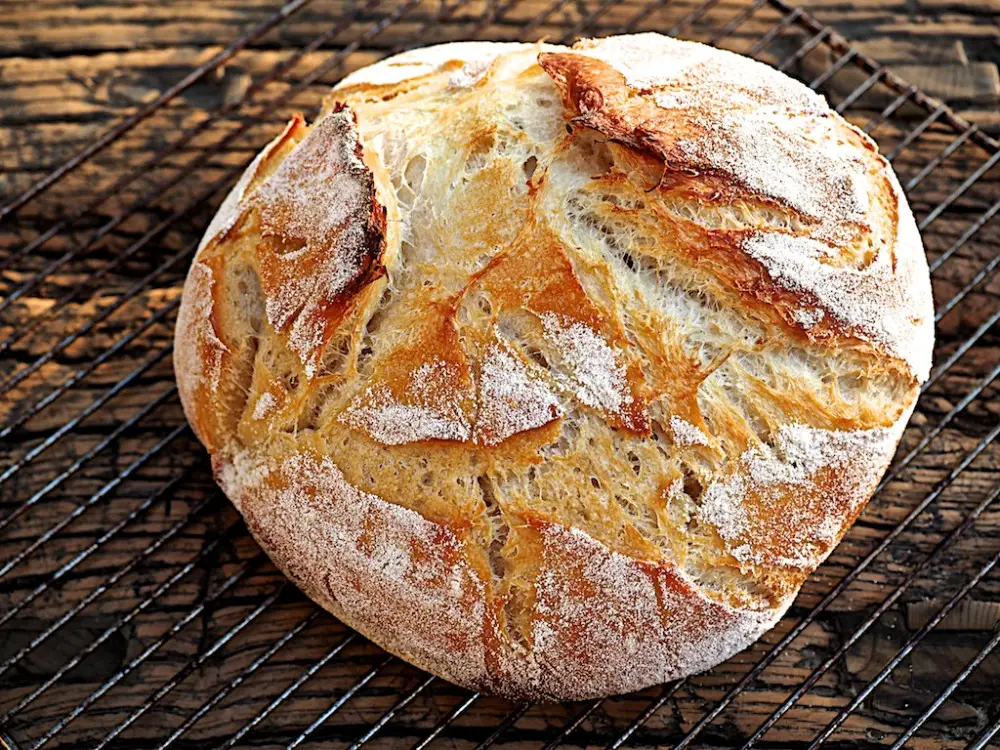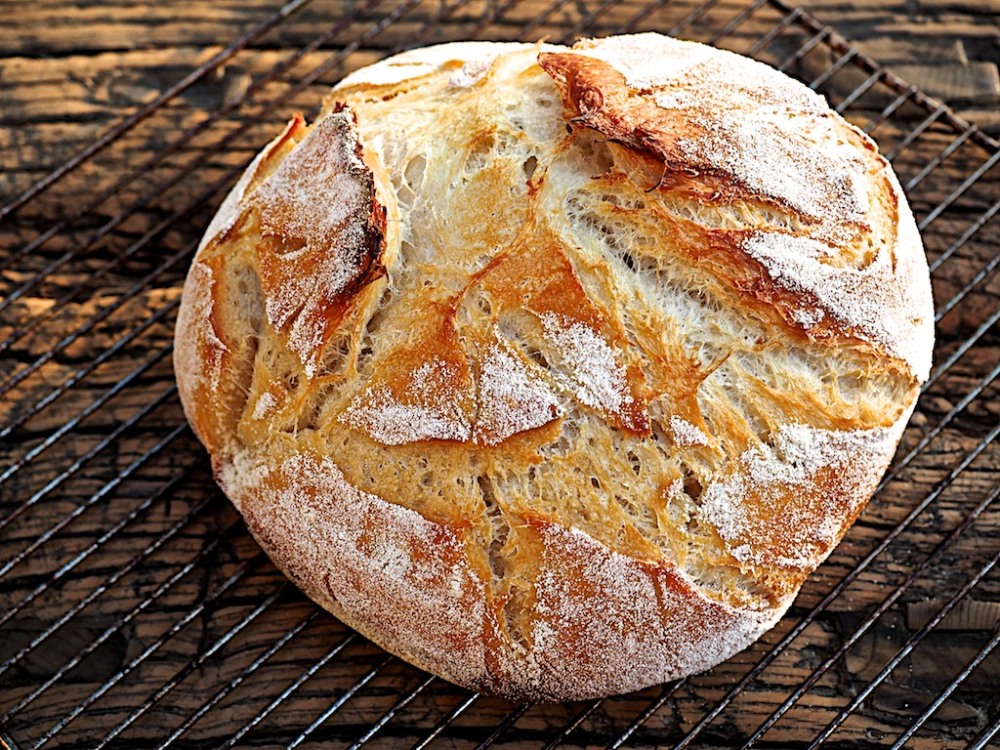Home-made Sourdough
Home-made Sourdough
Before you venture into the exciting world of sourdough baking, let me give you a word of warning: this method is not meant to be approached if you need instant gratification. Sourdough-making is a labour of love and it requires dedication, constance and patience. The mature and robust flavour of sourdough can only be obtained by proving the dough for a a very long time, and by that I mean something around 12 to 18 hours. And this is only after you have manage to create a living wild yeast…Why would anybody even attempt to make it at home then? The answer is that sourdough making is an addictive pleasure, one you may never get rid of… These days I am committed to travel 40 km to source the finest ground milled baker’s flour, I plan my outings according to my starter’s feeding schedule and I have managed to initiate several friends to this ancient ritual, so that, in the event of a cataclysm and my starter cases to live, its offering still lives in someone else’s kitchen.. You do believe me now when I said I was addicted!
First off, let’s talk about the yeast, which is the rising agent of your bread. Making your own is relatively easy, but it requires daily care and attention. The principle is that if you mix flour and water in a bowl, the bacteria in the air and in the flour will react together creating a living organism that will then be fed by those same bacteria to become strong and lively. Like all living things yeast requires regular feeds and care in order to grow healthy and vigorous. You can create a sourdough starter, which is Italian is called Pasta Madre (mother dough) in about 10 days and , if kept well, it can last forever. And I mean forever. I know of some bakeries in Italy that have been using the same Pasta Madre for centuries. Talk about legacy! Once you succeed in creating the wild yeast, you have to sustain it to help it stay alive and strong. The flavour of your bread will be determined by the strength and fermentation of your starter. The older and the stronger your starter, the better tasting you bread will be. There are many methods you can try to follow in order to create you Pasta Madre. I have read countless books and spoken to many bread-making folks and I have had many more failures than I wish to recall. This is because each yeast will be slightly different from the next, therefore you have to take all tips and advise with a grain of salt and learn to trust your instinct. The method below is relatively quick and easy and it is tried and tested by me, and produces a lovely, crusty bread. I noticed that the more mature it gets, the better loaf it produces. I am looking forward to tasting my bread in the years to come, if I don’t kill my starter, that is!
HOW TO MAKE YOUR PASTA MADRE or STARTER or SOURDOUGH YEAST (they are all the same thing…)
Day 1
In a large plastic bowl mix together 120 gr (1 cup) plain or baker’s flour with 95 ml (1/3 cup + 2 tablespoons) of filtered water at room temperature and 1 teaspoon of honey or barley malt. The sugars will kick-start the fermentation process. Cover with a lid and leave at room temperature for 24 hours.
Day 2
You will notice your dough will have risen slightly and may have already formed small bubbles. Get rid of half of the dough and add 50 gr of flour (1/2 cup) and 40 ml (1/4 cup) of filtered water.
Repeat for 8 days. Every day you will notice the starter will grow bigger and develop more bubbles. It will smell a little like a cross between lemon juice and alcohol.
Day 10 – it’s alive!
This is the day your yeast will officially be born and may be used to mix your first loaf. You need to ‘refresh’ it and give it strength and vigor for your bread to rise. In simple terms, you need to feed it.
First feed
As soon as you wake up in the morning, discard 100 g of the ferment then add 2/3 cup (100 g) plain flour and 90 ml water. Cover with a lid and rest for 3 hours.
Second feed
Feed your ferment 2/3 cup (100 g) plain flour and 90 ml water. Cover with a lid and rest for 3 hours.
Last feed
Feed your ferment 2/3 cup (100 g) plain flour and 90 ml water. Cover with a lid and rest for 3 hours.
After it has rested, your yeast will look healthy, airy and full of bubbles (in colder climate this may take longer than 3 hours). It will have a slightly sour, yet pleasant smell. Congratulations! You have succeeded in making a living wild yeast. You can now use it to mix your first loaf.
How to maintain your lievito madre
The wild yeast you have created will happily live in your fridge, stored in an airtight plastic container. You will have to feed it at least once a week to keep it healthy and alive. If you don’t have time to mix a loaf, but only need to give your starter some dinner, rest it at room temperature for 30 minutes, then discard one third. Add 1/3 cup (50 g)/4 tablespoons plain flour and 40 ml (or 2 tablespoons) of filtered water (at room temperature) for every 100 g of yeast you have left (aim to always have at least 100 g yeast in your container). Mix with a wooden spoon or a chopstick, cover the container with its lid and stick it back in the fridge until next time. A well-kept yeast will live a long, prolific life. Some Italian bakeries are known to be using centuries-old lievito madre. As a rule of thumb, the older your yeast, the more flavoursome your bread will be. No wonder sourdough bread is so good!
SOURDOUGH LOAF RECIPE (Pane di casa):
240 gr (1 cup) starter
500 gr (4 cups) organic flour
300 ml (1 cup 1/4) filtered water
6 gr (2 teaspoons) of salt
A teaspoon of honey or barley malt (optional)
1. Mix flour and water in a large ceramic or plastic bowl with a wooden spoon, and let it rest for about 1 hour. This process is called Autolayse and it allows for flavour and texture to develop. It is not a mandatory step, but I recommend it.
2. Add your starter and knead for about 5 minutes, then add salt and honey , if using any. Knead well for about 10 minutes, until your dough is smooth and silky.
Shape it into a ball and let it rest, covered, for 20 minutes, then stretch it gently with your hands to form a rectangle and fold into three. This process will give your dough strength and texture.
3. Cover with oiled cling wrap and let it prove in a warm place for 3 to 4 hours.
Kead again, gently, for a minute , fold into three and shape into a ball and then place it a proving basket or a colander lined with a tea towel and dusted with semolina. Rest it the fridge covered, with a moist cloth, to slowly prove for 12 hours. I normally put it in the fridge at night before dinner and forget about until the next day. You can leave it to slow prove in the fridge for a few days, if you wish so. This process is called Retardation and it will develop the fermented flavour of the crumb and the characteristic crunchiness of the crust.
4. The next morning, leave your dough at room temperature for at least 2 hours. It should grow in size by 1/3 third.
 5. Preheat you oven to 200C (390 F). Place a small metal bowl in the oven to heat up. Gently, turn the bread onto an oven tray lined with baking paper, sprinkle it with a little water and score it in a X pattern. Immediately insert the tray into the even, pour a cup of cold water into the metal bowl to create steam and close the oven door. Bake for 30-35 minutes or until crusty and bronzed, the bottom sounds hollow when tapped and the fragrance of freshly baked bread is intoxicating. Rest at room temperature for at least 1 hour before slicing.
5. Preheat you oven to 200C (390 F). Place a small metal bowl in the oven to heat up. Gently, turn the bread onto an oven tray lined with baking paper, sprinkle it with a little water and score it in a X pattern. Immediately insert the tray into the even, pour a cup of cold water into the metal bowl to create steam and close the oven door. Bake for 30-35 minutes or until crusty and bronzed, the bottom sounds hollow when tapped and the fragrance of freshly baked bread is intoxicating. Rest at room temperature for at least 1 hour before slicing.
Silvia’s Cucina is on Facebook , Twitter and Instagram
Silvia’s Cucina the cookbook is now available in stores and online!
This site contains product affiliate links. We may receive a commission if you make a purchase after clicking on one of these links.





